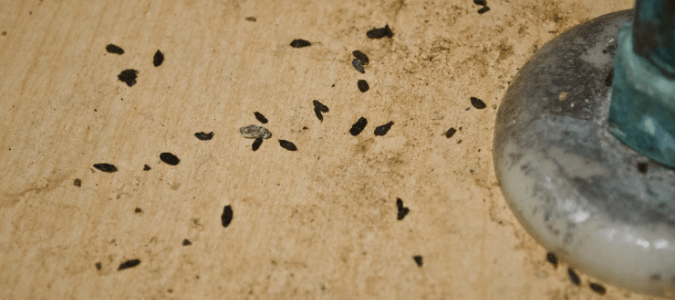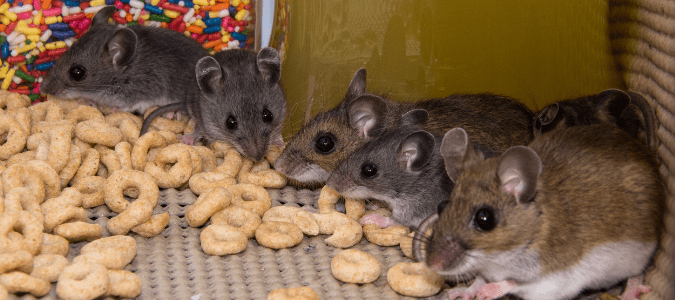
If you spot small, dark-brown pellets in a corner of your garage or in the back of a kitchen cabinet, you may wonder if you’ve found evidence of a rodent infestation. As your blood pressure starts to rise, a series of questions may begin to cycle through your head, including: What do mouse droppings look like? How are they different from rat droppings? How similar are they to cockroach feces? And, perhaps most importantly: What should I do next if I determine that I have mice living in and around my home?
Rats and mice look similar to each other, and so it stands to reason that are similarities between their droppings as well. But there are also marked differences between these two rodents and the waste materials they leave behind. If you do find signs of either rats or mice—or both—you’ll want to take action, as you do not want either animal to enter or breed in your home. Once you identify which type of pest you’re dealing with, you can take a series of steps to remove them and prevent them from returning.
It’s understandable that so many people live in fear of rodents getting into their homes: Mice can cause extensive property damage if they are allowed to nest and breed. They are also known carriers of diseases like hantavirus and Salmonella that can make humans sick. Even pets can suffer ill effects from mice. Furthermore, mice are incredibly prolific breeders. A single female mouse can produce as many as fifty or more babies in one year. If you think you may have a mouse problem, this is why it’s a good idea to address it as soon and as decisively as possible so it doesn’t grow exponentially worse.
If you’ve found mouse droppings somewhere in your home, you may be able to identify other signs of rodent activity as well. In fact, there are several common signs that people tend to notice when they have a mouse infestation:
- Mouse droppings, which look like small, elongated pellets, dark brown in color, with pointed ends. They can be anywhere from less than a quarter-inch in length to half an inch in length—around the size of a grain of rice—while rat droppings are larger, smoother and more blunt on the ends. Mouse droppings and cockroach droppings can easily be mistaken for each other, but cockroach droppings will have ridges on them. Droppings that are gray in color and are easily crumbled indicate that these droppings are older and could be from a prior infestation. You can test this by sweeping up the droppings and inspecting the area a week afterward. If new droppings are present, this indicates an active infestation.
- Nesting materials, such as torn paper, cloth or insulation. Mice use these found materials to build nests in hidden-away spots such as inside the walls or in the backs or on top of cabinets, so they can breed.
- Squeaking or scratching sounds coming from within the walls or ceiling—especially at night—since mice, rats and many other rodent pests are nocturnal. Many people report their pets staring fixedly at seemingly random points on the wall or ceiling. What could be happening is that your pet may actually be detecting rodent noises.
- Gnaw marks on baseboards, drywall, PVC piping, cabinets, food containers or wooden rafters. Like rats, mice must gnaw frequently to file down their constantly growing front teeth. Their chewing can cause costly damage, and can even cause a fire hazard if they happen to gnaw through electrical wiring.
- Mouse sightings, whether live or dead. While mice are most active at night, they may also be seen at times during daylight hours. Naturally cautious, they tend to stay close to the baseboards or walls and typically avoid walking out in the open. If you are wondering if what you saw is a mouse or a rat, you should know that mice have brownish or grayish fur; long, wiry tails; rounded ears; beady black eyes; and whiskers flanking pink, pointed noses. Mice are quite a bit smaller than rats, however. They typically grow to be two or three inches in length at full maturity (not counting their tails), while rats grow to six inches or even longer in body length.
If you notice any signs of a mouse infestation in and around your home, it’s time to take action. For most people dealing with mice, the best approach is a comprehensive one. This means taking steps on your own to deter mice from entering or nesting anywhere in the home or elsewhere around the property, while also enlisting the aid of a reputable wildlife control specialist. These professionals can properly identify a pest infestation, remove existing mice and take further steps to deter these pests from returning in the future.
Since we are more likely to see signs of a rodent infestation than an actual rat or mouse, it is difficult for the average homeowner to know what type of rodent is on their property. That’s important when you are trying to control a rodent population, however, as foods you should put in a mouse trap are different from foods that will attract rats. Keep reading to learn the differences between a rat problem and a mouse problem.

How To Tell if You Have Rats or Mice
If you suspect you may have a rodent pest problem, you may wonder how to tell if you have rats or mice. As we’ve already mentioned, one way is by looking at the size and other characteristics of their feces. While both mice and rats drop dark-brown, elongated pellets, mouse droppings are smaller and pointier at the ends. Rat droppings, by contrast, are larger and thicker, and also smoother and more rounded at the ends. Norway rat droppings are a bit larger, with pellets measuring anywhere from half of an inch to three-quarters of an inch in length. Roof rats produce droppings that are typically a third of an inch to half of an inch in length and can be pointed at the ends.
You can also tell whether you have rats or mice by looking at the number of droppings you’re finding. Rats typically produce 50 droppings a day, while mice typically produce 70 droppings a day.
If you spot an actual rodent, you can usually tell whether it’s a rat or mouse by its size and color. Rats’ fur can range from brownish to red-ish gray, while wild mice are normally dusky gray in color. Rats can grow to be quite large, with bodies that are six or more inches long and thick, scaly, hairless tails. Mice, as are pictured above, grow to be just a few inches long, with thinner tails that have a bit of hair on them. Also, rats typically leave greasy rub marks along walls and baseboards where they travel, while mice don’t leave any detectable grease marks.
If you’re sure you have some type of rodent infestation, but you aren’t certain whether it’s rats or mice, the surest way to tell is to hire a pest management specialist to inspect your property and confirm what animal pest you’re dealing with. A professional knows where to check and what signs to look for in determining the type of pest infestation you have. Then, these experts can devise a multi-pronged plan to eliminate the pest infestation and prevent these unwanted rodents from returning.

Rodent Proofing Your Home and Property
Rodent proofing requires some know-how and diligence, but it’s worth the effort for the peace of mind you’ll gain from knowing you’re doing all you can to keep pests away. Following some relatively simple, common-sense steps will help you deter rats, mice and other pests from entering or nesting inside your home, garage, outdoor shed or anywhere else on your property.
Steps you can take to rodent-proof property include:
- Look for any gaps or holes, even very small ones, that rats or mice might use to enter your home or garage, and close them off with steel wool, wire mesh or caulk. Keep in mind that mice can squeeze through spaces the size of a dime. These wily rodents can access the interior of your home through tiny openings around vents or hose bibs, in the eaves or around door or window frames. They are more likely to do this during the colder months when they are most in need of warmth, as well as food and shelter, but they might enter your home at any point throughout the year.
- Keep all food stored properly in pest-proof containers. This goes for pet food, birdseed and people food, all of which should be stored in airtight containers with well-fitting lids. Pet food and water bowls should be put away at night and the kitchen should be kept clean, since crumbs and food items left out overnight could attract several different types of pests.
- Fix any leaky pipes or faucets, whether indoors or outdoors, so they won’t supply rodents with a readily available water supply.
- Store garbage and recycling in bins with tightly fitting lids to deter pests of all types from entering them.
- Keep compost inside a bin rather than out in the open. If you have fruit trees, try not to let fallen fruit accumulate on the ground, as this draws rats and mice, as well as insect pests.
- Trim grass, bushes, trees and other landscaping, as rats and mice often use piles of dead leaves, branches or mulch for nesting outdoors. Additionally, these creatures are excellent climbers. This means rats and mice can get into your attic by climbing up trees and using overhanging branches that you may have neglected to prune to travel from our roof into your attic and home.
- Use traps rather than poison to keep rat and mice populations under control. These products can be toxic to any animal that comes into contact with them, not just rats and mice. Setting out traps in out-of-the-way spaces that rats and mice may frequent can be effective if you set enough traps in the right places. However, you ma find that your mileage may vary, as many homeowners report that rodents won’t go near their traps.
Even if you follow all of the above steps faithfully, you could still find yourself dealing with a mouse problem. Mice and other wild rodents are have adapted well to living in close proximity with humans, relying on the food, water and shelter that we unwittingly supply them. This is why many people turn to pest control professionals to help them get rid of rodents. If you try to deal with these issues on your own, you may waste valuable time and grow increasingly frustrated over time as your efforts fail to work. Wildlife control specialists have access to tools and techniques that are proven to work in keeping pests away from your home and garage, so you can have peace of mind that your home is pest-free.
ABC Can Get Your Rodent Problem Under Control
Dealing with a rodent problem can feel like a never-ending, distasteful chore. Instead of wasting time and money trying to deal with a pest problem on your own, contact ABC Home & Commercial Services. Our licensed professionals will strategically set traps and can provide ongoing pest management services, so you don’t have to deal with any more unwanted rodents.
